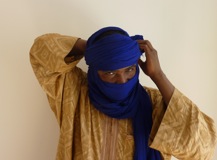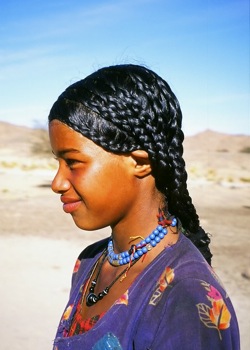CLOTHING : ISELSA
FASHION / HAIRSTYLE / HEADDRESS
Covering of the body among Imuhar (Tuareg) nomads is subject to social and cultural norms. Usually the entire body has to be covered. Casual wear is mainly made of cotton and it functions also as work clothing. It is worn day and night. By using the textile veiling of the body several messages can be transmitted. As clothing is gender-specific distinctions are made obvious since a very young age.
Women`s Garments
Tesirnest
TESIRNEST AND ROBA
Women typically wear long, colourful dresses (roba) with a wrap robe (Tesirnest) on top.
Outer garment
A Tesirnest is piece of cloth, approximately 2 x 5 m. The woman ties this cloth across their shoulders by applying a special knot, Then the woman wraps it around her body, including the head.
Under garment
Women usualy wear a long dress underneath the Tesirnest. Such dress (Roba) is made of cotton, preferably adorned with small flower motifs. A more contemporary version worn instead of a traditional roba is a long skirt and a t-shirt. For women it is of high importance that all garements are long sleeved. During the winter season nomad women sometimes wear sweaters or vests on top of their dress.
Bukar
BUKAR AND ROBA
While younger women like to wear colourful robes (tesirnest) in their everyday life, older women usually prefer indigo-coloured robes (bukar) on top of a dress (roba). The indigo colour of the bukar rubs off easily, and the skin rapidly assumes a bluish color. For this reason the Imuhar are also known as the “blue people”. Traditionally, the thick cotton of the bukar is dyed in Kano, Nigeria. It is produced with a wax-like coating, which results in the irisdescent indigo effect. After repeated washing however the sturdy fabric resembles washed out denim.
Types of use
The Tesirnest as a working cloth fulfil a variety of functions. Wrapped around the body they are keeping women warm during winter. Work regarding wood requires the lower half of the robe being tied up. This is that the cloth doesn’t get caught in the thorns of the acacias. The robe can either be tied up in a way that it resembles a pouch which is useful for carrying stuff. Or the lower part of the robe is completely tied around the belly of the women. By tying the robe around their shoulders nomad women gain more room for arm movement. Furthermore the upper part of the tesirnest can be tied back in a way that only a headwear with a sash remains leaving the undergarment completely uncovered. Small objects like pieces of sweet resin are commonly tied directly onto the cloth.
A tesirnest is adaptable to climatic and ecological conditions. Every woman has her individual way of making use of their robe. Meanwhile the dress worn beneath the robe is never shortened or tied in any way. In the camps the tesirnest is usually wrapped around the whole body covering the entire undergarment – especially when men are present.
Men`s Garments
Men usually wear medium-length cotton shirts on top of t-shirts and wide, long trousers (ekerbey). Their turban-like headgear (tagelmust/chech) is rarely taken off, even during work.
Outer garment
The long cotton shirt is fitted with long, wide sleeves. It either covers the knees or extends all the way to the ankles. Typically the cotton shirt is held in one single color, although nowadays also colorful variations are found among young men. Some men own a jacket for cold winter months.
Under garment
Usually men wear t-shirts with short sleeves. The trousers worn are very wide. They’re commonly worn with a belt and are more tight around the ankles. The pants as the cotton shirt are preferred from the same material.
Types of use
While women’s garments are extremely flexible men’s wear is hardly varied. Occasionally the lower half of the long shirt is tied up when working with acacias.
Children`s Garments
Very young children are usually dressed with a t-Shirt or shirt. Boys wear t-shirts with pants, and girls wear skirts on top of pants. When a girl gets her first menstruation she also receives a tesirnest to wear for the first time.
Formal Wear
Imuhar (Tuareg) nomads place a special emphasis on their robes. They highly value their indigo-dyed clothes. During celebrations like weddings, religious holidays, or naming ceremonies, the nomads wear their best outfits and most beautiful robes.
WOMEN
Women usually chose indigo robes (bukar) for festivities. Beneath the bukar women wear long colourful dresses.
GIRL
On festive occasions young girls wear single coloured, wide and long dresses.
MEN
Men wear long shirts with matching pants made out of damask. Usually they wear a large turban called tagulmust or tagelmust.
BOYS
Boys typically wear long shirts and matching trousers.
Headdress
A distinctive piece of clothing of the Imuhar nomads is the head covering, which is already widely studied. Distinctive and broadly studied attires are the Imuhar nomads’ headgears.
WOMEN / ALESCHU:
Elderly women usually wear a veil (aleschu) that covers the hair beneath the tesirnest. With the aleschu parts of the face can be covered (as seen on the cover of the book SPRECHKUNST DER TUAREG).  Aleshu
Aleshu
The most expensive and most popular aleschu is made out of shimmering indigo cotton. The veil is typically made up of narrow strips (approx. 2cm) that are manually sewn together. It is usually 2 to 3 metres long and 60cm broad. The aleschu or the tesirnest can be used to cover the face only leaving the eyes exposed. Traditionally the face gets covered up in the presence of men especially male visitors. This is a way of communication that is based on honour. Younger women normally do not wear an aleschu, but sometimes a coloured headscarf.
Tagelmust
MEN / TAGELMUST
The large headgear of the men is called tagulmust while the small one is called chech. Imuhar use the wrapping technique as a way to identify the wearer. Young men tie chechs so that some hair is visible. Elderly men tend to wear a tagulmust.
The headgear offers various possibilities of expression. Sometimes only the eyes are visible while on other occasions the whole face can be seen. A Tagulmust that consists of several narrow indigo-dyed cotton strips that are sewn together is very expensive. Indigo or white are usually the favoured colours worn on feast days. In everyday life especially young men (ishumar) wear a yellow, pink, blue, purple, black, red or green cotton chech. Chech
How to wrap a Tagulmust (Tagelmust/Tagoulmoust)
In order to make your own tagelmust you need a piece of cotton cloth (approx. 60x200cm):
The cloth required for a big tagulmust can be 4 metres or even longer. The smaller version of the tagulmust is called achech (or chech, aschesch, schesch). In the following the wrapping of an chech is explained in a few steps.



Take the cloth and put it on top of your head leaving one metre of the right end falling down the side of the head.
Take the left end and wrap it around your chin and around the whole head in a vertical manner.
Take the piece in front of the mouth, twist and then fix it as shown in photo 4.



Pull the left tail to tighten the cloth covering your chin, mouth and nose.
Then lightly twist the left tail of the cloth and wrap it around your head horizontally.
Wrap the cloth tightly around your head for a few times.


Then tuck the left end in on the side.
Pull it downwards underneath your chin.
The bigger tagelmust requires wrapping the cloth around the head repeatedly. In Niger a small silver roll with a religious saying is typically added in the festive version of the tagelmust.
Footwear

Imuhar nomads used to wear self-made leather sandals. Later on rubber from tires was added to strengthen the soles.
Women’s shoes
Up to ten years ago most women had rubber slippers (flip-flops). Plastic sandals from Italy were initially only worn by men. But soon elderly women started wearing them as well. Nowadays the shoes are more feminine. Some women even wear small heels. As the desert is a rather rough environment shoes made out of plastic usually do not last long.
Men’s shoes
Beside plastic sandals men wear leather sandals that are more resilient. Shoes that are not open are hardly ever in use as sand fills them up rather quickly. Hiking boots (typically left behind by tourists) are rarely used as well.
Children’s shoes
Kids rarely wear shoes. Only for special occasions they wear rubber slippers or plastic sandals.
Types of use
The ways in which footwear is used communicates a lot about the person wearing it. Visitors are usually welcomed wearing sandals. Before sitting down shoes have to be taken off. When entering a tent shoes are usually left in front of the entrance.
Hairstyle

Women:
Nomad women prefer long hair. Girls and young women often wear a full braided hairstyle. Usually,the mother braid multiple braids on each side and a pigtail at the back of the head. Older women usually wear two twisted long braids.
Men:
Today, younger as well as elder men wear a short haircut.
Shopping
Due to their children and livestock Imuhar nomad women are usually restricted to the desert. Therefore it is up to the men what they buy when visiting an oasis. Men are the ones trading and purchasing the required clothing.
Western clothing is available at local markets. And even though it is valued but it never obtains the same cultural status as traditional clothing. Attires are always connected to certain social groups. Hence clothing is a symbol of self-definition.
